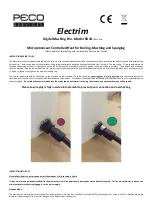
OV2PTOV has two voltage steps, each of them with inverse
or definite time delayed.
OV2PTOV has a high reset ratio to allow settings close to
system service voltage.
Residual overvoltage protection, two steps
ROV2PTOV
M13808-3 v12
Residual voltages may occur in the power system during
earth faults.
Two step residual overvoltage protection (ROV2PTOV)
function calculates the residual voltage from the three-
phase voltage input transformers or measures it from a
single voltage input transformer fed from an open delta or
neutral point voltage transformer.
ROV2PTOV has two voltage steps, each with inverse or
definite time delay.
A reset delay ensures operation for intermittent earth faults.
Overexcitation protection OEXPVPH
M13319-3 v9
When the laminated core of a power transformer or
generator is subjected to a magnetic flux density beyond its
design limits, stray flux will flow into non-laminated
components that are not designed to carry flux. This will
cause eddy currents to flow. These eddy currents can cause
excessive heating and severe damage to insulation and
adjacent parts in a relatively short time. The function has
settable inverse operating curves and independent alarm
stages.
Voltage differential protection VDCPTOV
SEMOD153862-5 v7
A voltage differential monitoring function is available. It
compares the voltages from two three phase sets of voltage
transformers and has one sensitive alarm step and one trip
step.
Loss of voltage check LOVPTUV
SEMOD171457-5 v8
Loss of voltage check (LOVPTUV ) is suitable for use in
networks with an automatic system restoration function.
LOVPTUV issues a three-pole trip command to the circuit
breaker, if all three phase voltages fall below the set value
for a time longer than the set time and the circuit breaker
remains closed.
The operation of LOVPTUV is supervised by the fuse failure
supervision FUFSPVC.
Radial feeder protection PAPGAPC
GUID-82856D0B-5C5E-499A-9A62-CC511E4F047A v3
The radial feeder protection (PAPGAPC) function is used to
provide protection of radial feeders having passive loads or
weak end in-feed sources. It is possible to achieve fast
tripping using communication system with remote end or
delayed tripping not requiring communication or upon
communication system failure. For fast tripping, scheme
communication is required. Delayed tripping does not
require scheme communication.
The PAPGAPC function performs phase selection using
measured voltages. Each phase voltage is compared to the
opposite phase-phase voltage. A phase is deemed to have
a fault if its phase voltage drops below a settable
percentage of the opposite phase-phase voltage. The phase
- phase voltages include memory. This memory function has
a settable time constant.
The voltage-based phase selection is used for both fast and
delayed tripping. To achieve fast tripping, scheme
communication is required. Delayed tripping does not
require scheme communication. It is possible to permit
delayed tripping only upon failure of the communications
channel by blocking the delayed tripping logic with a
communications channel healthy input signal.
On receipt of the communications signal, phase selective
outputs for fast tripping are set based on the phase(s) in
which the phase selection function has operated.
For delayed tripping, single pole and three pole delays are
separately and independently settable. Furthermore, it is
possible to enable or disable single pole and three pole
delayed tripping. For single phase faults, it is possible to
include a residual current check in the tripping logic. Three
pole tripping is always selected for phase selection on more
than one phase. Three pole tripping will also occur if the
residual current exceeds the set level during fuse failure for
a time longer than the three pole trip delay time.
9. Frequency protection
Underfrequency protection SAPTUF
M13349-3 v13
Underfrequency occurs as a result of a lack of generation in
the network.
Underfrequency protection (SAPTUF) measures frequency
with high accuracy, and is used for load shedding systems,
remedial action schemes, gas turbine startup and so on.
Separate definite time delays are provided for operate and
restore.
SAPTUF is provided with undervoltage blocking.
The operation is based on positive sequence voltage
measurement and requires two phase-phase or three
phase-neutral voltages to be connected.
Overfrequency protection SAPTOF
M14953-3 v12
Overfrequency protection function (SAPTOF) is applicable
in all situations, where reliable detection of high
fundamental power system frequency is needed.
Overfrequency occurs because of sudden load drops or
shunt faults in the power network. Close to the generating
plant, generator governor problems can also cause over
frequency.
Line differential protection RED670
1MRK 505 379-BEN R
Version 2.2
Hitachi Energy
45
© 2017 - 2022 Hitachi Energy. All rights reserved
















































